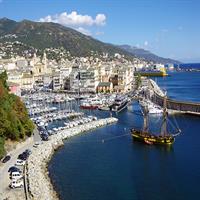Day 1 in Bastia
Welcome to the Bastia, one of the oldest and
largest towns in Corsica! Upon arrival, make your transfer to your destination,
arrive at your hotel, check in and do not give in to jet lag! There is so much
for you to see and do.
Bastia, Corsica`s second largest city, sits beautifully on
Corsica`s east coast, facing Italy with views out to the Tuscan archipelago. We
suggest you start your visit at Place
St Nicolas, a pleasant spot to soak up Bastia`s Mediterranean
atmosphere, this is a social hub of the town. Stop in for lunch at one of the
many attractive cafes in the area and soak in the essence of the people and
culture. (Also, there is a small tourist train that starts its tour in the Place St Nicholas and
spends 45 minutes passing by the main sights in Bastia.)
The
Boulevard aolis
and Rue César Campinchi are the main
shopping streets running parallel to Place St Nicolas square. Spend some time getting acquainted as you wander amongst the ambient stores of the
city.
The old town
(or the `Terra Vecchia`)
lies south of Place St Nicolas and surrounds the Old Port of Bastia which cannot
be missed. You will be drawn in with its faded charm of narrow streets and
alleys, where washing still hangs out to dry from ancient shuttered windows in
the tall, often almost crumbling, buildings, dating back from the 18th
century. It is the character of
this part of Bastia, merging into the old port, which is the most fascinating aspect of Bastia,
so make sure to allow time to explore.
One
of the main squares in the old town is the Place du Marche, which is home to a morning market and
the large Saint-Jean-Baptiste
church, an imposing church built in the 16th century. The
interior of the church was renovated in baroque style in the 18th century.
Nearby on Rue Napoleon is the Oratoire
St Roch with a great Baroque interior and also the Oratoire de l`Immaculée Conception,
which has a particularly luxurious interior including crystal chandeliers.
Continue
walking, at the other side of the Saint Jean Baptiste church is the charming
port where the rather neglected buildings surround the harbor full of boats
ranging from small fishing vessels to gleaming pleasure boats.
There are two ports in Bastia: the
original traditional one (old port), and the more recent port where Corsica Ferries arrive
with passengers from Italy and France. The old harbor is the popular place to
spend your evenings in Bastia, and a great area to finish off your day, in one
(or a few) of the many bars and restaurants. There is a promenade along the
waterfront that is great for strolling. Be sure to walk out along the Quai des Martyrs de la Liberation
for the best views of the harbor.


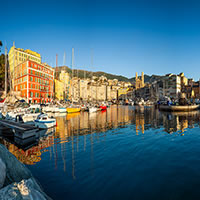
Day 2 in Bastia
Start your day early and head to market square, the Place de l`Hôtel de Ville, or the City Hall Square (It`s right next to the Saint-jean Baptiste church) to
enjoy a local farmers market. The main weekly markets are held here each Saturday and Sunday, with
smaller markets in the same square on other days. (There is a flea market in
the Place Saint Nicholas each Sunday.)
The market is a
meeting place and a great way to get a glimpse at the everyday life of the
locals. Grab some breakfast and take in the feast of colors, flavors and scents.
Stock up on Corsican products such as cheese, charcuterie and fruits and
vegetables, amongst many other unique items.
As afternoon approaches, continue your
exploration of Bastia by heading to the other side of the old harbor around the
substantial citadel.
This part of the town is much
trendier if slightly less impressive than its old town neighbor. The walk to
the citadel passes through the
gardens (le Jardin Romieu) and past the once-very-posh houses
of the Terra Nova district.
The main buildings within the citadel of Bastia are the grand 14th century Governor`s Palace,
protected by defensive walls added during the 15th century, and a
couple of churches: the church of Sainte-Marie de l`Assomption and
the Baroque
Oratoire-Sainte-Croix with its `black Christ`.
The palace of the Governors was
attacked and destroyed by Nelson in 1794 and rebuilt by the French when it was
used as a prison. The Nazi`s used the dungeons to imprison and torture
Resistance fighters during the Second World War. It has now been renovated and
is home to the Municipal Museum
with exhibits including the history of Bastia and Corsica from its pre-Roman
origins to its role in the Second World War.
Spend the remaining part of your
day at one of the several
nearby beaches close to Bastia, a great way to enjoy a Corsican
sunset. The best beach here is the Arinella Beach just about a mile south of Bastia town
center, which is a long sandy beach with many activities available. If you head
north from bestial, you`ll discover several small pebble beaches such as Minelli Beach.
After another busy day of exploring Bastia,
spend a relaxing evening at one of the many delicious restaurants in town. Enjoy
some local Corsican cuisine before heading back to your hotel for a restful
night sleep.


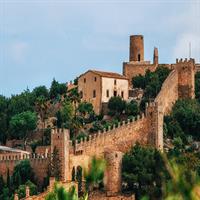
Day 3 in Bastia
On your last day in Bastia, we
recommend heading just outside the city to discover the area around Bastia on
the route called the `Upper
Corniche`, which has several very attractive views back across
town and the coast. The route passes through Montserrato, Cardo, Ville-de-Pietrabugno and San-Martino-di-Lota, heading into the western
edge off Cap Corse.
Cap Corse,
often called the island within the
island, is a beautiful peninsula to explore with
small fishing villages charmingly set against a backdrop of mountains that run
down the center of the peninsula. A driving tour is the perfect way to discover
the many villages, scenery, ports and beaches. There are several splendid
viewpoints as you pass around the peninsula.
The road
that tours Cap Corse is about 78 miles long, but that does not include the side
trips to the places that give Cap Corse a lot of its charm. You will more
likely end up driving closer to 100 miles, and a lot of it is on slow roads.
Much of the attraction of Cap Corse is the scenery, and this is
more enjoyable if you can leave your car behind occasionally and walk along a
beach or a coastal footpath. There are various possibilities to explore the
peninsula and it`s villages with many highlights to be discovered.
Macinaggio is a small
town with a port and a few cafes and shops, but is better known as the starting
point of the coastal path that follows around the north, passing various
beaches and carrying on passed Barcaggio,
one of our favorite beaches on Corsica.
It is also at Macinaggio
where the road turns west to cross the Cap Corse peninsula, and allows you to
reach Barcaggio
by road, as well as the small port
of Tollare and the hillside village of Rogliano. All these places
are definitely worth a visit.
Now on the west coast, another highlight in north Cap Corse is the
port at Centuri.
Very unspoiled and extremely traditional, this picturesque port and village
involves a detour of about 6 miles, but is well worth it. It is also one of the
few places in the north of Cap Corse to have a great selection of restaurants.
Exploring the Cap Corse peninsula will easily take you a full day,
and could easily be longer depending on how many stops you make throughout the
trip. A complete circuit of the Cap Corse will take you about four hours
(without stops) and we recommend that you drive in a clockwise direction so
that you are always in the inside lane (the road can be narrow and winding and
drops are steep and rather scary!). When traveling on the east coast of the
peninsula, the road is usually quite near sea level but on the west it is
usually higher, with cliffs and mountains and paths descending to the coast.
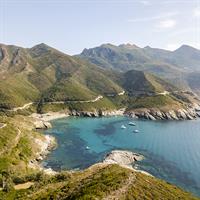
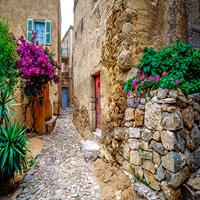

Additional Days in Bastia
Should you be able to spend additional
days in Bastia we recommend a visit the Etang de Biguglia south of Bastia. This is the largest
lagoon on the island and a haven for migrating birds. More than 100 species
can be observed here, whilst the beach of la
Marana provides a great spot for a relaxing afternoon.
Another enjoying day trip is the Castagniccia
(literally meaning `small chestnut grove`), wherein lies a chestnut forests. Many
of the wild boar that are eaten on the island each year are caught in this
area, but despite this, many of the villages in the area now lie abandoned. ON
a clear day, the altitude offers views over the Tuscan Islands, occasionally,
the snow-capped peaks of the Alps are visible. The highest peak in the region,
Monte San Petrone can be a challenging hike, but the view from the top, both
out towards Italy and back into the Casuluna valley, are well worth the energy.

Your Last Day in Bastia
Depart your hotel for the train station, ferry or airport where you will head home or make your way to more Corsican adventures. Savor the memories of a very special time in the city of Bastia.
